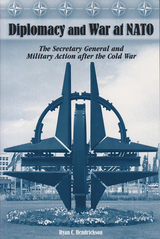 Diplomacy and War at NATO: The Secretary General and Military Action After the Cold War
Ryan C. Hendrickson
University of Missouri Press, 2006 NATO is an alliance transformed. Originally created to confront Soviet aggression, the North Atlantic Treaty Organization evolved in the 1990s as a military alliance with a broader agenda. Whether conducting combat operations in the Balkans or defending Turkey from an Iraqi threat in 2003, NATO continues to face new security challenges on several fronts. Although a number of studies have addressed NATO’s historic evolution, conceptual changes, and military activities, none has considered the role in this transformation of the secretary general, who is most often seen as a minor player operating under severe political constraints. In Diplomacy and War at NATO, Ryan C. Hendrickson examines the first four post–Cold War secretaries general and establishes their roles in moving the alliance toward military action. Drawing on interviews with former NATO ambassadors, alliance military leaders, and senior NATO officials, Hendrickson shows that these leaders played critical roles when military force was used and were often instrumental in promoting transatlantic consensus. Hendrickson offers a focus on actual diplomacy within NATO unmatched by any other study, providing previously unreported accounts of closed sessions of the North Atlantic Council to show how these four leaders differed in their impacts on the alliance but were all critical players in explaining how and when NATO used force. He examines Manfred Wörner’s role in moving the alliance toward military action in the Balkans; Willy Claes’s influence in shaping alliance policies regarding NATO’s 1995 bombing campaign on the Bosnian Serbs; Javier Solana’s part in shaping political and military agendas in the Yugoslavian war; and George Robertson’s efforts to promote consensus on the Iraqi issue, which culminated in NATO’s decision to provide Turkey with military defensive measures. Through each case, Hendrickson demonstrates that the secretary general is often the central diplomat in generating cooperation within NATO. As the alliance has expanded its membership and undertaken new peacekeeping missions, it now confronts new threats in international security. Diplomacy and War at NATO offers readers a more complete understanding of the alliance’s post–Cold War transformation as well as policy recommendations for the improvement of transatlantic tensions.
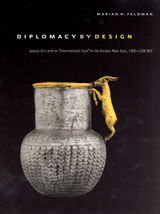 Diplomacy by Design: Luxury Arts and an "International Style" in the Ancient Near East, 1400-1200 BCE
Marian H. Feldman
University of Chicago Press, 2006 Art and international relations during the Late Bronze Age formed a symbiosis as expanded travel and written communications fostered unprecedented cultural exchange across the Mediterranean. Diplomacy in these new political and imperial relationships was often maintained through the exchange of lavish art objects and luxury goods. The items bestowed during this time shared a repertoire of imagery that modern scholars call the first International Style in the history of art.
Marian Feldman's Diplomacy by Design examines the profound connection between art produced during this period and its social context, revealing inanimate objects as catalysts—or even participants—in human dynamics. Feldman's fascinating study shows the ways in which the exchange of these works of art actively mediated and strengthened political relations, intercultural interactions, and economic negotiations. Previous studies of this international style have focused almost exclusively on stylistic attribution at the expense of social contextualization. Written by a specialist in ancient Near Eastern art and archaeology who has excavated and traveled extensively in this area of the world, Diplomacy by Design provides a much broader consideration of the symbolic power of material culture and its centrality in the construction of human relations.
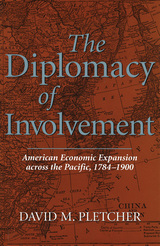 The Diplomacy of Involvement: American Economic Expansion across the Pacific, 1784-1900
David M. Pletcher
University of Missouri Press, 2001
Like its predecessor, this important new work is focused on the connection between trade and investment on the one hand and U.S. foreign policy on the other. David Pletcher describes the trade of the United States with the Far East, the islands of the Pacific, and the northwest coast of North America from 1784 (the year of the first American trading expedition to China) to 1844 (the year of the first trade treaty with China, followed immediately by the U.S. acquisition of Oregon and California). He then traces the growth of trade and investment in Alaska, Hawaii, and the South Pacific from 1844 to 1890 and proceeds to do the same for China, Japan, and Korea. In the ensuing chapters, Pletcher covers the 1890s, including the annexation of Hawaii, the Sino-Japanese War, the acquisition of the Philippines, and the Open Door policy in China.
He concludes that the American expansion across the Pacific and into the Far East was not a deliberate, consistent drive for economic hegemony but a halting, experimental, improvised movement, carried out against determined opposition and indifference and dotted with setbacks and failures. Providing his own judgments about the wisdom and effectiveness of America's new endeavors, Pletcher summarizes the problems and handicaps involved, demonstrating that errors of the twentieth century were at least partly the result of poor preparation in the 1880s and 1890s.
Touching on every place where Americans undertook significant economic activity, The Diplomacy of Involvement will be an important aid for seasoned scholars, as well as an excellent introduction for the novice.
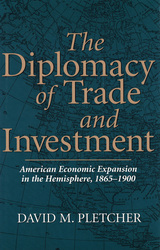 The Diplomacy of Trade and Investment: American Economic Expansion in the Hemisphere, 1865-1900
David M. Pletcher
University of Missouri Press, 1998
The move to encourage trade with Canada and Mexico during the 1990s, culminating with the negotiation of the North American Free Trade Agreement (NAFTA), has had a long background extending as far back as the late eighteenth century. American trade with both Canada and Latin America rapidly increased during the last third of the nineteenth century as a result of burgeoning industry and agriculture in the United States. The Diplomacy of Trade and Investment is the first detailed examination of the economic and political forces behind this rapid growth and their effect on government policy.
Based on a thorough examination of government documents, congressional debates and reports, private papers of government and business leaders, and newspapers, David M. Pletcher begins this monumental study with a comprehensive survey of U.S. trade following the Civil War. He goes on to outline the problems of building a coherent trade policy toward Canada, Mexico, Central America, the Caribbean, and South America. The study concludes by analyzing a series of abortive trade reform efforts and examining the effects of the Spanish-American War.
Pletcher rejects the long-held belief that American business and government engaged in a deliberate, consistent drive for economic hegemony in the hemisphere during the late 1800s. Instead he finds that the American government improvised and experimented with ways to further trade expansion. But American businessmen were often more interested in domestic trade than in trade with foreign markets. In fact, many of them resisted efforts to lower the American tariff or otherwise encourage American trade abroad.
The combination of traditionalist and revisionist insight with Pletcher's own deep knowledge and research provides the reader with a comprehensive new interpretation of hemispheric trade expansion at the end of the nineteenth century.
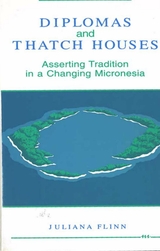 Diplomas and Thatch Houses: Asserting Tradition in a Changing Micronesia
Juliana Flinn
University of Michigan Press, 1992 Diplomas and Thatch Houses examines the people of Pulap, a tiny atoll just north of the Equator in the western Pacific. Pulapese consider themselves and are known to their neighbors as the most traditional islanders, a situation they regard as an asset and not as a sign of backwardness. Pulapese deliberately wear their lavalavas and loincloths and practice traditional dances and rituals. Rather than being just a remnant of the past, tradition for the Pulapese is created and displayed as a means of asserting cultural identity. Like other Micronesians, the Pulapese view a person less as an isolated, independent individual and more as a link in a network of relationships. Behavior, more than biology or descent, shapes identity. The Pulapese manipulate their "traditional" identity as a political tool--as an adaptive strategy to contend with the rapid changes wrought by a foreign administration. To the Pulapese, tradition is politically valuable; they fiercely contend that their customs and patterns of behavior entitle them to prestige and power in modern Micronesia. Diplomas and Thatch Houses is an important contribution to the literature on ethnicity, nationality, and cultural identity, as well as to Micronesian/Pacific studies.
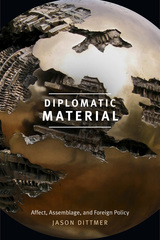 Diplomatic Material: Affect, Assemblage, and Foreign Policy
Jason Dittmer
Duke University Press, 2017 In Diplomatic Material Jason Dittmer offers a counterintuitive reading of foreign policy by tracing the ways that complex interactions between people and things shape the decisions and actions of diplomats and policymakers. Bringing new materialism to bear on international relations, Dittmer focuses not on what the state does in the world but on how the world operates within the state through the circulation of humans and nonhuman objects. From examining how paper storage needs impacted the design of the British Foreign Office Building to discussing the 1953 NATO decision to adopt the .30 caliber bullet as the standard rifle ammunition, Dittmer highlights the contingency of human agency within international relations. In Dittmer's model, which eschews stasis, structural forces, and historical trends in favor of dynamism and becoming, the international community is less a coming-together of states than it is a convergence of media, things, people, and practices. In this way, Dittmer locates power in the unfolding of processes on the micro level, thereby reconceptualizing our understandings of diplomacy and international relations.
 Direct Action: Radical Pacifism from the Union Eight to the Chicago Seven
James Tracy
University of Chicago Press, 1996 Direct Action tells the story of how a small group of "radical pacifists"—nonviolent activists such as David Dellinger, Staughton Lynd, A.J. Muste, and Bayard Rustin—played a major role in the rebirth of American radicalism and social protest in the 1950s and 1960s. Coming together in the camps and prisons where conscientious objectors were placed during World War II, radical pacifists developed an experimental protest style that emphasized media-savvy, symbolic confrontation with institutions deemed oppressive. Due to their tactical commitment to nonviolent direct action, they became the principal interpreters of Gandhism on the American Left, and indelibly stamped postwar America with their methods and ethos. Genealogies of the Civil Rights, antiwar, and antinuclear movements in this period are incomplete without understanding the history of radical pacifism.
Taking us through the Vietnam war protests, this detailed treatment of radical pacifism reveals the strengths and limitations of American individualism in the modern era.
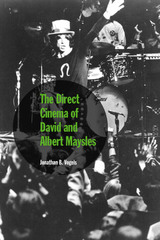 The Direct Cinema of David and Albert Maysles
Jonathan B. Vogels
Southern Illinois University Press, 2005 Boldly signifying the cultural issues of the 1960s and 1970s in groundbreaking pieces such as Grey Gardens, Gimme Shelter, and Showman, filmmakers and brothers David and Albert Maysles used an approach to documentary film that involved spontaneous observation of naturally occurring events. With no rehearsed footage and no preconceived plots, their revolutionary work eschewed the authoritative voice-over narrator, didactic scripts, and the traditional problem-and-solution format used by the majority of their predecessors in the genre and duly influenced subsequent directors in both fiction and nonfiction film. Their collaboration from 1962 until David’s death in 1987 wrought thirteen major works in which the brothers critiqued the concept of celebrity with unglamorous footage of iconic figures, explored how commercialism hinders communication, and questioned the possibility of seeing anything clearly in a world abounding with both real and constructed images. Jonathan B. Vogels outlines how the Maysles brothers blended a unique amalgam of direct cinema characteristics, a modern humanist aesthetic, and a collaborative working process that included other directors and editors. Looking at the films as both shapers and reflections of American culture, he points out that the works offer insights into a wide range of contemporary topics including materialism, celebrity, modern art, and the American family. In addition to describing the changes in technology that made direct cinema possible, Vogels provides careful, scene-by-scene analyses that allow for a consideration of the Maysles brothers’ films as films, a tactic not frequently employed in nonfiction film studies.
Direct Reference, Indexicality, and Propositional Attitudes
Edited by Wolfgang Künne, Albert Newen, and Martin Anduschus
CSLI, 1997 This volume is a compilation of revised versions of papers presented at a conference held in spring 1994 at the Centre for Interdisciplinary Research (ZiF) in Bielefeld, Germany.
| |